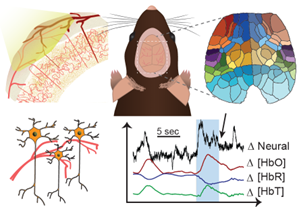You are here
Neurovascular imaging in health and disease
Speakers
Abstract
Elevations in neuronal activity in the brain are almost always accompanied by a local increase in blood flow. This neurovascular coupling generates the blood oxygen level dependent (BOLD) signals detected in functional magnetic resonance imaging (fMRI). Although it is generally accepted that normal neurovascular coupling is essential for brain health, little is understood about the purpose of functional hyperemia, its cellular mechanisms and how it might be altered in disease states. A major challenge for studying neurovascular coupling is the lack of measurement techniques that can provide comprehensive, real-time simultaneous recordings of neuronal activity and brain hemodynamics.
The Hillman lab has pioneered the development and application of wide field optical mapping (WFOM) methods that can image both neuronal activity and hemodynamics across the brain of awake, behaving mice. WFOM leverages genetically encoded calcium sensitive fluorophores, along with the oxygenation-dependent diffuse reflectance of hemoglobin, and can be acquired while head-fixed mice are free to move and behave on a horizontal wheel. We have used this method to study wide ranging aspects of neurovascular coupling, starting from charting and benchmarking functional hyperemia, exploring the early post-natal development of neurovascular coupling and exposing the role of endothelial propagation of vasodilation in neurovascular coupling. Questioning whether neurovascular coupling ever ‘breaks’ we have explored the effects of a range of drugs, as well as disease states such as glioma, acute stroke and the effects of cortical spreading depressions. Using mathematical modelling that relates neuronal activity, hemodynamics and real-time behavior, we are exploring how disease states perturb these relationships. Ultimately, we hope to explore how aspects of neurovascular and neuro-behavioral dysfunction contribute to aberrant brain health with the hope of discovering new biomarkers, therapeutic targets and treatments.

